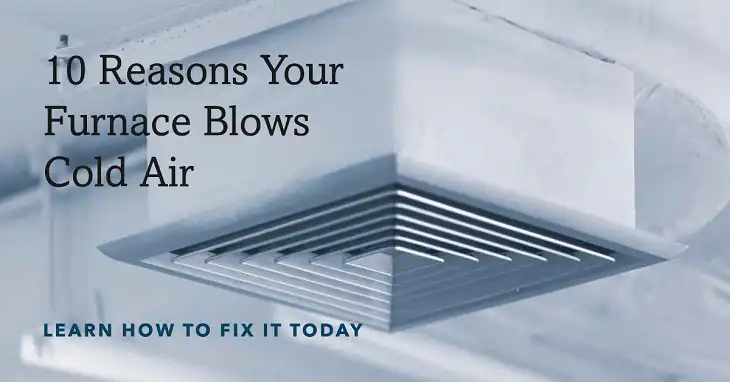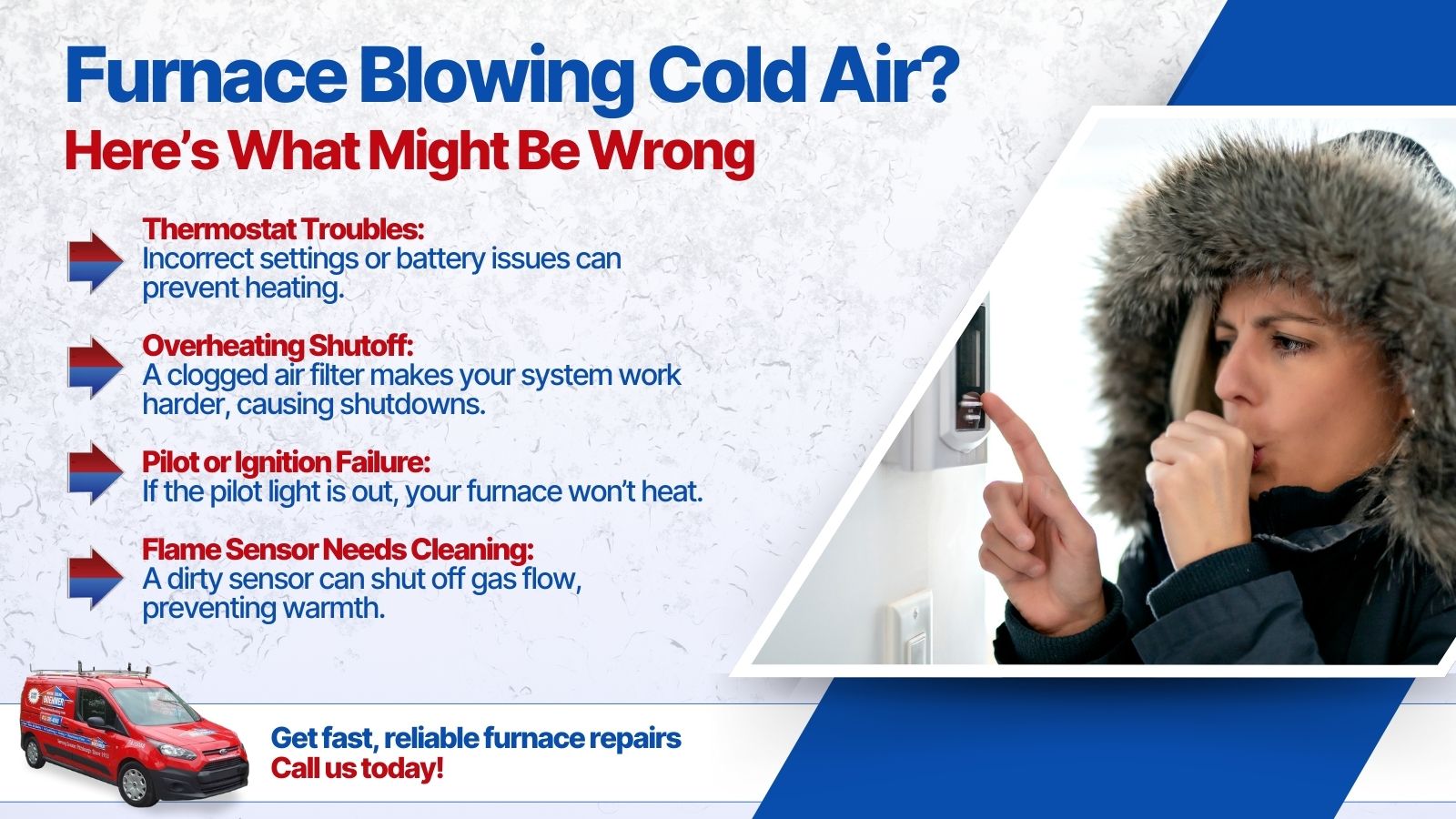Furnace Blowing Cool Air Instead Of Heat

It's a homeowner's nightmare: you crank up the thermostat on a chilly day, expecting a wave of comforting warmth, only to be greeted by a blast of cool air. A furnace blowing cold air instead of heat is a common problem, but diagnosing the cause can be tricky. More importantly, resolving the issue promptly is crucial, not just for comfort, but also for your energy bill and the lifespan of your HVAC system.
Common Culprits Behind a Cold Air Furnace
Before calling in a professional, there are several potential reasons why your furnace might be acting up that you can investigate yourself. Remember to always turn off the power to your furnace at the breaker box before attempting any DIY troubleshooting.
The Thermostat is the First Suspect
It might seem obvious, but double-check your thermostat settings. Ensure it's set to "Heat" and that the set temperature is significantly higher than the current room temperature. A simple oversight here can lead to a surprisingly cold house. Many smart thermostats also have scheduling features. Make sure the schedule is programmed correctly to call for heat when you expect it.
ROI Potential: A smart thermostat, like a Nest Learning Thermostat or an ecobee SmartThermostat, can learn your heating and cooling patterns, automatically adjusting the temperature to save energy. Energy Star estimates that properly programmed thermostats can save homeowners up to 10% on their heating and cooling bills. Furthermore, some utility companies offer rebates on smart thermostat purchases, further improving the return on investment.
Pilot Light Problems (For Older Furnaces)
If you have an older furnace with a pilot light, check if the pilot light is lit. A blown-out pilot light is a frequent reason for a furnace to stop producing heat. Relighting the pilot light is usually a simple process, but consult your furnace's manual for specific instructions and safety precautions. If the pilot light repeatedly goes out, there may be a problem with the gas supply or the thermocouple, requiring professional attention.
Gas Supply Issues
Ensure your gas supply is turned on. Check the gas valve near the furnace and the main gas meter. If you suspect a gas leak, evacuate the premises immediately and contact your gas company. Never attempt to fix a gas leak yourself.
Dirty Air Filters
A clogged air filter is one of the most common reasons for a furnace to blow cold air. A dirty filter restricts airflow, causing the furnace to overheat. To prevent damage, the furnace may shut down the burner, resulting in cool air being circulated. Inspect your air filter monthly and replace it every one to three months, or more frequently if you have pets or allergies. Using a high-efficiency particulate air (HEPA) filter can also improve air quality, but ensure your furnace can handle the increased air resistance.
Energy Savings Tip: A clean air filter not only prevents your furnace from blowing cold air, but also improves its overall efficiency. Energy Star recommends regularly changing air filters to maintain optimal performance and reduce energy consumption. Dirty filters force your system to work harder, increasing energy bills and potentially shortening the lifespan of your furnace.
Overheating
As mentioned before, restricted airflow due to a dirty filter can cause the furnace to overheat, triggering a safety shut-off. However, other factors, such as a faulty blower motor or blocked vents, can also lead to overheating. If you suspect overheating, turn off the furnace and call a qualified HVAC technician.
Flame Sensor Problems
The flame sensor is a safety device that detects whether the burner is lit. If the flame sensor malfunctions, it will shut off the gas supply, preventing the furnace from overheating. A dirty or faulty flame sensor is a common cause of a furnace blowing cold air. Cleaning the flame sensor with fine steel wool may resolve the issue, but it's best to consult a professional for diagnosis and repair.
Limit Switch Issues
The limit switch is another safety device that prevents the furnace from overheating. If the limit switch trips, it will shut off the burner. A tripped limit switch can be caused by a variety of factors, including a dirty air filter, blocked vents, or a faulty blower motor. Resetting the limit switch may temporarily resolve the issue, but it's essential to identify and address the underlying cause.
The Furnace is Going Through a Start-Up Cycle
Some furnaces will blow cool air for a few moments during the start-up cycle. This is normal as the system warms up. However, if the furnace continues to blow cold air for an extended period, there's likely a problem.
Professional Help is Needed
If you've checked the thermostat, pilot light, gas supply, and air filter, and your furnace is still blowing cold air, it's time to call a qualified HVAC technician. Attempting to diagnose and repair complex furnace issues yourself can be dangerous and may void your warranty.
An HVAC technician can diagnose a range of potential problems, including:
- Faulty blower motor
- Gas valve issues
- Problems with the heat exchanger
- Ignition problems
- Control board failures
The Importance of Regular Furnace Maintenance
Preventive maintenance is crucial for ensuring your furnace operates efficiently and reliably. Regular maintenance can help prevent breakdowns, extend the lifespan of your furnace, and save you money on energy bills. Schedule an annual furnace tune-up with a qualified HVAC technician. During a tune-up, the technician will clean and inspect the furnace, check for potential problems, and make necessary repairs.
Cost Savings: A well-maintained furnace operates more efficiently, reducing energy consumption and lowering your heating bills. Regular maintenance can also prevent costly repairs down the road. Many HVAC contractors offer maintenance plans that include annual tune-ups and priority service.
Upgrade to a High-Efficiency Furnace
If your furnace is old or inefficient, consider upgrading to a high-efficiency model. Modern furnaces are significantly more efficient than older models, saving you money on energy bills and reducing your carbon footprint. Look for furnaces with an Annual Fuel Utilization Efficiency (AFUE) rating of 90% or higher. Energy Star certified furnaces are also a good choice, as they meet strict energy-efficiency guidelines.
Government Incentives: Many states and utility companies offer rebates and tax credits for installing high-efficiency furnaces. Check with your local utility company and the Energy Star website to learn about available incentives. These incentives can significantly reduce the upfront cost of upgrading your furnace, making it an even more attractive investment.
Smart Home Integration: Integrating a new, high-efficiency furnace with a smart thermostat and other smart home devices can further optimize energy savings and improve comfort. For example, you can use smart sensors to monitor room temperature and adjust the thermostat accordingly. You can also use smart vents to direct airflow to specific areas of your home, ensuring consistent temperatures throughout.
Addressing Specific Furnace Issues
Sometimes, the cold air issue presents itself in very specific ways. Here are a few common scenarios:
Furnace Blowing Cold Air for a Few Minutes Then Starts Heating
This is often related to the initial startup cycle. The blower fan may kick on before the heat exchanger has warmed up. This is usually normal, but if it persists for longer than a few minutes, it could indicate a problem with the ignition system or gas supply.
Furnace Blowing Cold Air Only on the First Cycle
This could be due to residual cold air in the ductwork from when the furnace was last off. It could also indicate a problem with the furnace's ability to quickly reach its operating temperature. A technician should inspect the gas pressure and burner efficiency.
Furnace Blowing Cold Air in One Room Only
This likely points to a problem with the ductwork in that specific room. Check for blocked vents, leaks in the ductwork, or improperly sized ducts. Insulating the ductwork can also help improve heat distribution.
Conclusion
A furnace blowing cold air instead of heat is a frustrating problem, but with a little troubleshooting, you can often identify the cause and resolve the issue. Remember to prioritize safety and consult a qualified HVAC technician if you're uncomfortable performing any repairs yourself. By maintaining your furnace, upgrading to a high-efficiency model, and integrating smart home technology, you can ensure your home stays warm and comfortable throughout the winter while saving money on energy bills.
Take Action: Schedule an annual furnace tune-up with a trusted HVAC contractor. Explore energy-efficient furnace options and available rebates. Invest in a smart thermostat to optimize your heating and cooling costs. By taking these steps, you can create a more comfortable, energy-efficient, and cost-effective home.










